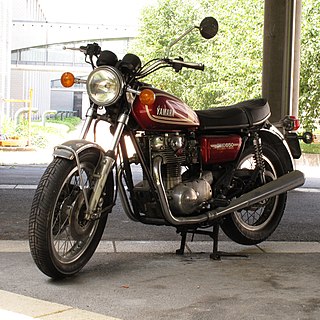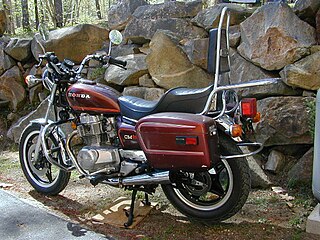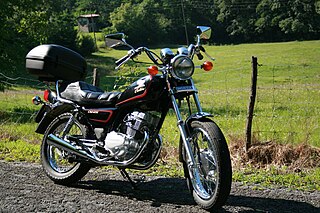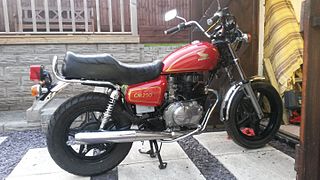
The Honda Magna was a cruiser motorcycle made from 1982 to 1988 and 1994 to 2003 and powered by Honda's V4 engine taken from the VF/VFR. The engine technology and layout was a descendant of Honda's racing V4 machines, such as the NS750 and NR750. The introduction of this engine on the Magna and the Sabre in 1982, was a milestone in the evolution of motorcycles that would culminate in 1983 with the introduction of the Interceptor V4. The V45's performance is comparable to that of Valkyries and Honda's 1800 cc V-twin cruisers. However, its mix of performance, reliability, and refinement was overshadowed by the more powerful 1,098 cc "V65" Magna in 1983.

The Honda CB750 is an air-cooled, transverse, in-line four-cylinder engine motorcycle made by Honda over several generations for year models 1969–2003 as well as 2007 with an upright or standard riding posture. It is often called the original Universal Japanese Motorcycle (UJM).
The Honda XR series is a range of four-stroke off-road motorcycles that were designed in Japan but assembled all over the world.

The Honda Shadow refers to a family of cruiser-type motorcycles made by Honda since 1983. The Shadow line features motorcycles with a liquid-cooled 45 or 52-degree V-twin engine ranging from 125 to 1,100 cc engine displacement. The 250 cc Honda Rebel is associated with the Shadow line in certain markets.

The Yamaha XS650 is a mid-size motorcycle made by Yamaha Motor Company. The standard model was introduced in October 1969,and produced through 1979. The "Special" cruiser model was introduced in 1978 and produced through 1985. The XS650 began with the 1955 Hosk SOHC 500 twin. After about 10 years of producing 500 twin, Hosk engineers designed a 650 cc twin. Later the Hosk company was acquired by Showa Corporation, and in 1960 Yamaha had bought Showa with Hosk's early design of 650 cc twin.

The Vulcan name has been used by Kawasaki for their custom or cruiser motorcycles since 1984, model designation VN, using mostly V-twin engines ranging from 125 to 2,053 cc.

The Fiat 124 Sport Coupé was a two-door, four-seater notchback coupé produced by the Italian automaker Fiat in three generations between 1967 and 1975. It was based on the Fiat 124 saloon.

The Honda CM400 is a street bike produced by the Honda Motor Company from 1979 to 1982, part of a series of motorcycles with the prefix 'CM' using various engine capacities. It was a precursor to the Honda Rebel series of motorcycles. It was equipped with electric start and electronic ignition. Models included the CM400A (Automatic), CM400C (Custom), CM400E (Economy) and CM400T (Touring). The CM400C was produced only in 1981, making it one of the rarer models.
The Suzuki Boulevard S50 is a motorcycle manufactured by Suzuki and released in 2005 and production stopped in 2009. It features an 805 cc v-twin engine with four valves per cylinder. It was formerly named the Intruder 1985 - 1991 VS 700 (USA), 1985 VS 750 VS 800.

The Harley-Davidson Sportster is a line of motorcycles produced continuously since 1957 by Harley-Davidson. Sportster models are designated in Harley-Davidson's product code by beginning with "XL". In 1952, the predecessors to the Sportster, the Model K Sport and Sport Solo motorcycles, were introduced. These models K, KK, KH, and KHK of 1952 to 1956 had a sidevalve engine, whereas the later XL Sportster models use an overhead valve engine. The first Sportster in 1957 had many of the same details of the KH including the frame, fenders, large gas tank and front suspension.

The Honda CB175 is a standard motorcycle made by Honda from 1969 to 1973. It had a 174 cc (10.6 cu in) four-stroke, straight-twin engine with a single overhead camshaft, two valves per cylinder, dual slide-valve carburetors, and dual exhausts. It was also equipped with a five-speed gearbox, 12-volt electrics, kick and electric start, front and rear drum brakes, turn signals, speedometer with trip meter, and tachometer, and was rated at 20 bhp (15 kW). An update in 1972, brought a more rounded gas tank and changes to the air box covers, along with some other minor trim changes. The CB175 was discontinued for 1974 and replaced by the CB200, a similar bike already in production. Although not technologically remarkable, Honda's small twins of the 1960s and 1970s were among their best sellers. Dual sport scrambler CL175 and touring CD175/CA175 versions were also produced.

The Honda Nighthawk 250 is a Honda standard motorcycle. It has a 234 cc (14.3 cu in) air-cooled parallel-twin engine. While the first Nighthawk (CB650) was manufactured in 1982, the first 250 Nighthawk was manufactured in 1991. It utilized the 1985–87 CMX250 Rebel engine with all new wiring and components and reshaped the Rebel cylinder head slightly as well as incorporating a larger carburetor and new valve cover. The motorcycle changed little over the years except for color. The Nighthawk 250 is essentially a light, maneuverable, inexpensive, economical, and easy to maintain bike. It is often used in Motorcycle Safety Foundation (MSF) motorcycle training. Its small size and low seat make it a popular model for riders of smaller stature. It has drum brakes and spoked wheels at front and rear, though later models in the Australian, U.K. and Japanese markets upgraded to front disc brakes and alloy wheels.

The Honda Ascot was a name given to two motorcycles produced by Honda in the early 1980s. The motorcycles that carried the name, the FT500 and VT500FT, were produced with the Ascot name between 1982 and 1984.

The Honda CM125 is a parallel twin cylinder air-cooled OHC four-stroke cruiser motorcycle made by Honda from 1978 to 2002. It had a top speed of 65 mph (105 km/h). The CM125C engine combines the single carburettor of the squat Honda CD125 Benly motor with the tall cylinder head and five-speed, gearbox of the sportier Honda 125 Super Dream.

The Honda CD250 is a 233 cc (14.2 cu in), air-cooled, four stroke, upright twin motorcycle which was retailed by Honda in the UK from 1988 to 1993. It has a single front disc brake and a rear drum. It has two into two exhausts, together with electric starting and capacitor discharge electronic (CDI) ignition.

The Honda CBR1000F Hurricane is a sport touring motorcycle, part of the CBR series manufactured by Honda from 1987 to 1996 in the United States and from 1987 to 1999 in the rest of the world. It is powered by a liquid-cooled, DOHC, 998 cc (60.9 cu in), 16-valve inline-four engine. The CBR1000F, along with the CBR750F and CBR600F, was Honda's first inline four-cylinder, fully-faired sport bike.

The Honda NX650 Dominator is a dual-sport motorcycle manufactured by Honda from 1988 to 2003. Honda sold the Dominator from the factory at $3,500 msrp. The engine was a slightly enlarged version of the tried and proven XR600R, around since 1985, with the 97 x 80mm bore enlarged to 100mm, stroked to 82mm, for a total of 644cc. This generated 44 horsepower at 6,000 rpm, with 53 lb-ft of torque at 5,000rpm. To smooth out vibrations created by the large single cylinder engine, a gear-driven counterbalancing system was installed. A single chain-driven overhead camshaft pushed down on the four valves, and the compression ratio was 8.3:1. Intake was via a 40mm Keihin constant-velocity carburetor, obtaining as much as 45 mpg from the 3.4 gallons in the tank. The Dominator had a dual exhaust that tucked alongside the rear fender. The powertrain was a wet clutch that powered a 5-speed gearbox. The bike featured a dry-sump engine in which the frame carries the oil supply. The non-adjustable fork had 41mm tubes and supplied 8.5 inches of travel; rake was 28.5 degrees, trail, 4.5 inches. A fork brace was built into the underside of the fender. Front wheel was a spoked 21-incher, carrying the standard 90/90 tire. And it had a single brake disc with twin-piston caliper. At the back, the single-shock setup allowed for preload alterations, with the rear wheel travel at 7.5 inches. The rear tire featured a drum brake. The foot pegs had rubber inserts, which appealed to the urban rider. If someone was interested in a more off-road situation, the inserts could be punched out, leaving saw-toothed metal pegs that are useful in slippery situations. The NX650 sold, but not in the numbers that Honda America had projected. The NX650 was off the US market after two short years, while the European version sold well all the way through 2003.

The Honda CM250 is a 234 cc (14.3 cu in) parallel twin cylinder air-cooled OHC four-stroke cruiser motorcycle produced by the Honda corporation from 1981–1983 with a top speed of 85 mph and delivering 70mpg. The 234cc North American market variant was coded as the CM250C and was the precursor to the current Honda CMX250C, also known as the Honda Rebel 250. The European market variant was identified as the CM250TB.

The Honda CB400T is a range of motorcycles built by Honda. In the United Kingdom it was known as the Dream, whereas in the United States it was known as the Hawk. A Honda CB250T version was also available for UK licensing reasons.

The Honda CD125TC Benly is a 124 cc (7.6 cu in), air-cooled, four-stroke, twin-cylinder "commuter" style motorcycle manufactured by the Honda Motor Company between 1982 and 1985 for the United Kingdom. Its engine size and power output were designed to conform to provisional licence restrictions of the time and it was a version of the Honda CD200 Benly introduced in the late 1970s, with the same four-speed constant mesh transmission but electric start only. The machine was identical in all other respects apart from the engine barrel size. It was equipped with an enclosed chain and capacitor discharge electronic ignition. Brakes were drum front and rear and it had both centre- and side-stands. Electrics were 12 volt, and the battery was housed in the right-hand, side-panel. The left-hand panel contained a small toolkit. Instrumentation was by way of two handlebar-mounted binnacles. One contained a speedometer, with odometer and trip meter and was in miles per hour with markings for kilometres and maximum speeds in gears. The other contained warning lights for main beam, ignition/neutral and indicators.


















